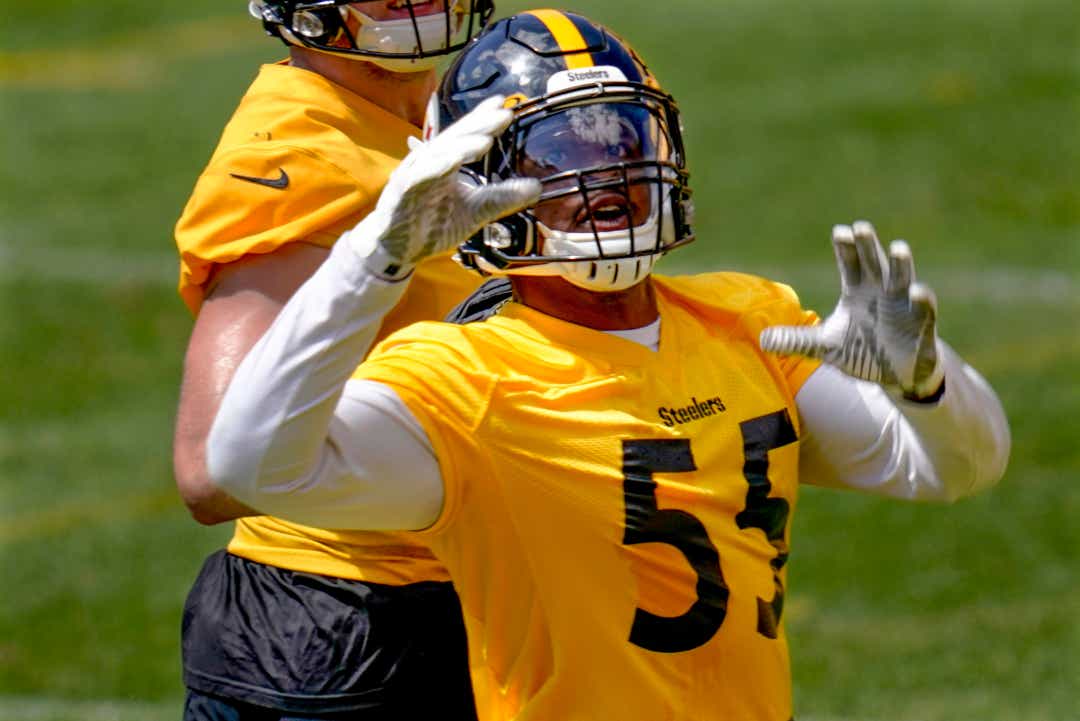Pittsburgh — Devin Bush’s speed was never in question. If anything, it’s one of the reasons the Pittsburgh Steelers traded up to grab the inside linebacker with the innate knack for getting to the ball as quickly as possible in the 2019 draft.
Yet for the former Michigan star to make “the leap” — the phrase Steelers head coach Mike Tomlin uses to describe what players need to do between their first and second seasons in the NFL if they want to succeed — the speed they need Bush to display won’t come from his legs but from between his ears.

Bush’s responsibilities entering 2020 will be more than just chasing the ball. He’s expected to be the one wearing the green dot that relays the call from the sideline to his teammates, and then help them adjust when necessary.
“I’m looking for that step to be revealed in the quality and the amount of his communication, and he still has room for improvement in that regard,” Tomlin said. “He’s better than he was, but as a defensive quarterback, I’m really looking for significant maturation in that area. He’s checking all the other boxes.”
The practice field on Friday offered proof. During a live 11-on-11 series, Bush sniffed out a screen pass to running back James Conner and split a couple of offensive linemen before taking Conner down for a loss. It was typical Bush, whose lack of relative height at 5-foot-11 isn’t a minus but a plus. He has the ability to slither around blocks with ease, his No. 55 often a blur before it reaches its destination. His 109 tackles led the NFL’s fifth-ranked defense, and he played all 16 games, heady territory while playing for a unit that historically brings along rookies slowly.
Not Bush, who doesn’t do much of anything slowly. Among the front seven, only outside linebackers Bud Dupree and TJ Watt played more than Bush’s 889 snaps. He did a little bit of everything, intercepting two passes, recovering four fumbles and getting a sack, though his playing time dipped over the second half as the wear and tear of playing 16 games caught up with him.
Bush understands his first season was solid if not always spectacular, and that more will be required if the Steelers are to return to the playoffs for the first time since 2017.
“I think last year I came in, went in and played (and) learned as things came to me,” Bush said. “Now, I have a pretty good idea of what I want to get done, how I can help this team win more, and what can I get better with as a player to help this team win.”
That means not just knowing where he needs to go, but knowing where the other 10 guys on the field in black and gold need to go, too. Though the COVID-19 pandemic forced the NFL to run its typical offseason schedule virtually — taking away organized team activities and minicamp, which typically serve as important checkpoints in player development — Bush believes he’s taken the necessary strides. Defensive coordinator Keith Butler’s scheme no longer seems so foreign.
“Just watching myself from last season and critiquing myself during the offseason, I definitely picked up the playbook a lot easier,” Bush said. “I’m a lot more comfortable with who I’m playing with and what scheme I am playing with. I have a good foundation that I laid down last year to build off. It should be a lot easier for me this year.”
The Steelers are counting on it. They cut veteran backup Mark Barron in March and didn’t seek any experienced player to put behind Bush and 31-year-old Vince Williams. The increase in substitution packages is part of the reason. Technically the team still runs a 3-4 defense, but Butler often mixes up things depending on game situations.
Still, if Pittsburgh’s defense is going to take another step forward as a whole, Bush needs to stay healthy and help the team avoid the communication issues that popped up, particularly early in the season.
“We think he’s really going to come alive for us a little bit this year,” Butler said. “He played well for us last year as a rookie, but once you’ve been there, he’s seen the game a little bit. He knows the speed of the game. He knows what we are going to call, for the most part. He’s got an idea of what we are going to expect of him.”